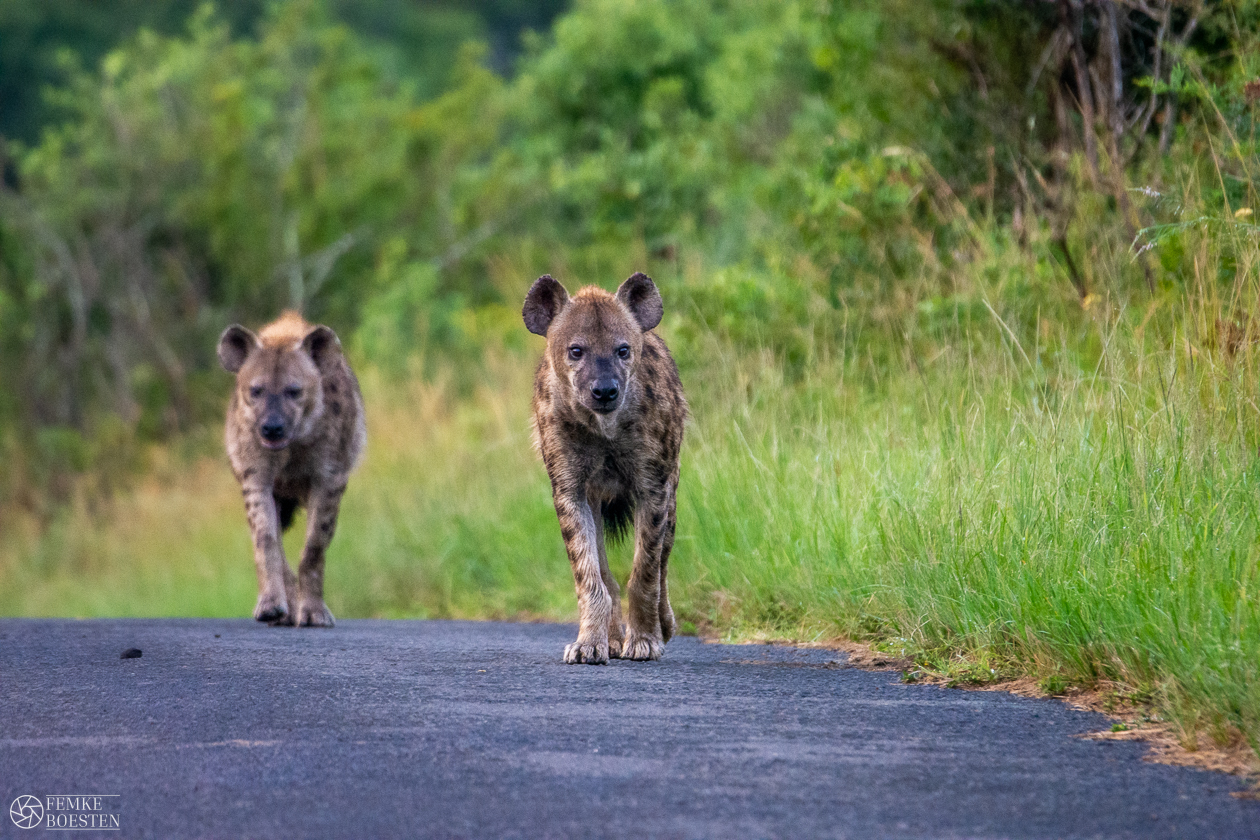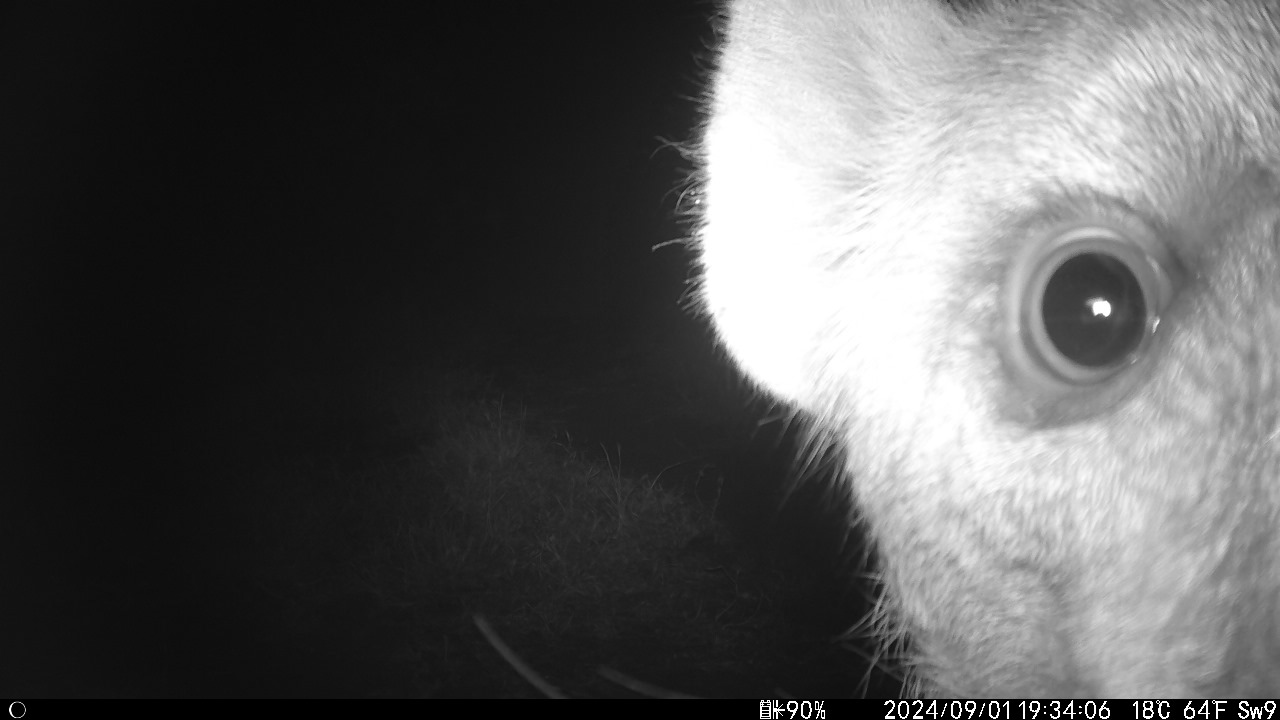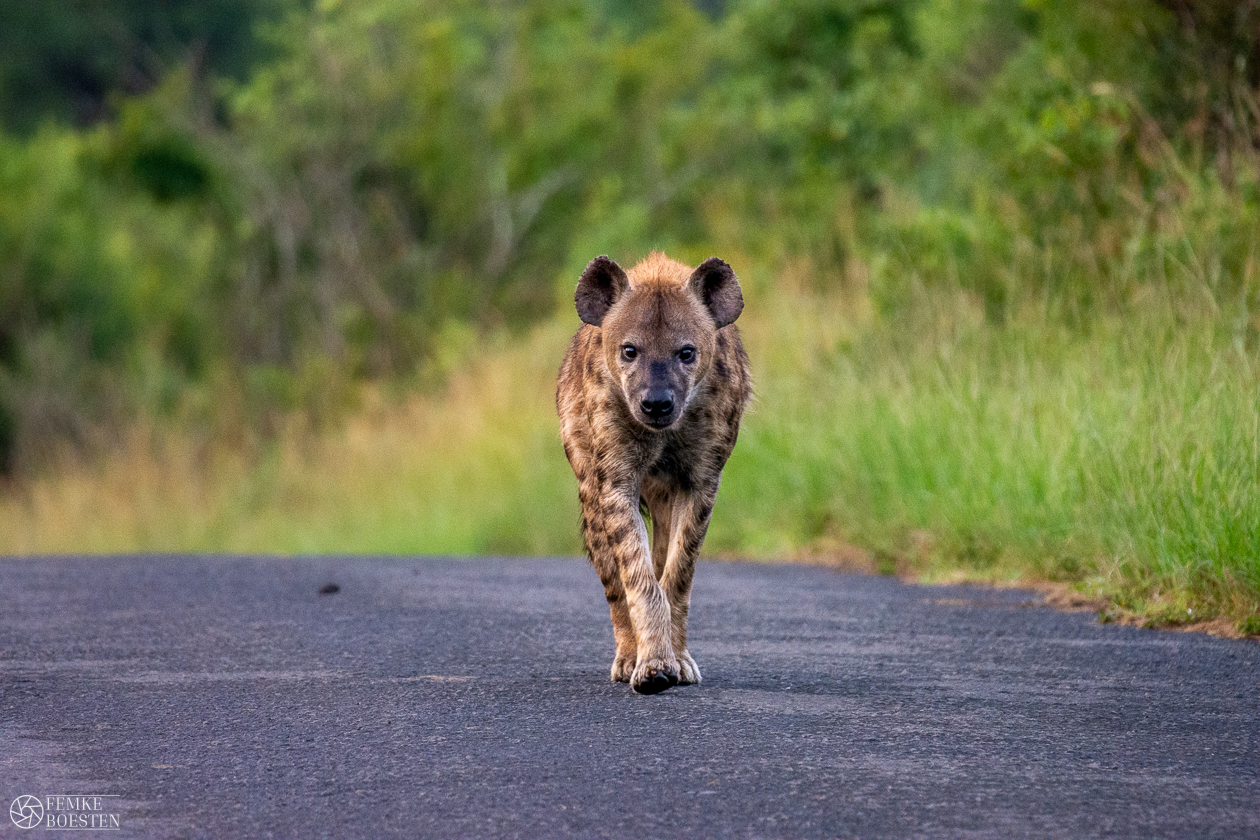Introduction to the Spotted Hyaena
The Spotted Hyaena (Crocuta crocuta) is one of Africa’s most adaptable large carnivores and plays an essential role in maintaining healthy ecosystems through both predation and scavenging. Known for their complex social structures and remarkable intelligence, these carnivores are far more sophisticated than their reputation suggests. Misconceptions have shaped public perception for decades, which makes clear, science-based information vital for understanding their true ecological importance.
Across Africa’s conservation landscapes, including the protected areas where Wildlife ACT operates, Spotted Hyaenas contribute to ecosystem stability by influencing prey populations, competing with other predators, and accelerating nutrient cycling. Wildlife ACT’s field teams collect long-term data on this species to support conservation authorities with reliable information on behaviour, movement, and population trends.
This work is strengthened by scientific research, including the Masters thesis completed by our Director of Nature and People, Peter Roberts, which examined Spotted Hyaena density and distribution in Hluhluwe-iMfolozi Park. Together, field monitoring and research continue to deepen our understanding of a species that is often misunderstood yet essential to functioning ecosystems.
Key Facts About the Spotted Hyaena
- Spotted Hyaenas have one of the strongest bite forces of any mammal and can crush large bones to access nutrient-rich marrow that most predators cannot reach.
- They can maintain speeds of up to 60 kilometres an hour and have the endurance to keep that pace over long distances when pursuing prey.
- Their famous “laugh” is a complex form of social communication that can signal excitement, stress, or submission depending on the context.
- Despite their scavenger reputation, Spotted Hyaenas are highly effective hunters and in many regions obtain most of their food through active predation.
- They play a vital disease-control role in ecosystems by consuming carcasses that could otherwise spread pathogens.
- Their adaptable nature allows them to thrive in a wide range of habitats, from semi-deserts to mountains, and they can survive with minimal water by obtaining moisture from prey.
- Clan structure and social cooperation allow Hyaenas to defend territories, coordinate movements, and raise cubs in communal den sites.
- In South Africa, approximately 5,000 individuals remain in the wild, and while populations within protected areas are stable, regional pressures continue to influence their long-term security.

Understanding the Spotted Hyaena
The Spotted Hyaena is often misunderstood, yet it remains one of Africa’s most adaptable and ecologically important carnivores. While commonly associated with scavenging, this species is also an efficient predator that supports ecosystem balance through both hunting and carcass consumption. Their ability to process large bones and access nutrient-rich marrow contributes to natural nutrient cycling and reduces the spread of disease from decomposing remains.
The species is currently listed as Least Concern both globally on the IUCN Red List and within South Africa on the SANBI Red List. Despite this classification, certain regional populations show signs of pressure, particularly where suitable habitat is fragmented or where conflict with livestock farming occurs. Estimates suggest that approximately 5,000 individuals remain in South Africa, and while populations inside well-managed protected areas remain stable, declines are more evident outside these landscapes.
Accurate information plays an important role in shifting long-standing misconceptions. Negative attitudes toward Spotted Hyaenas often stem from cultural narratives rather than ecological reality. By sharing clear, science-based understanding of the species, conservation organisations help build appreciation for their ecological value and support efforts that contribute to long-term population stability.
Spotted Hyaena Behaviour and Social Structure
Spotted Hyaenas live in structured social groups known as clans. These clans vary in size depending on habitat and resource availability, and they are centred around a dominant female hierarchy. Within these social groups, individuals use a wide range of vocal and scent-based communication to maintain cohesion, signal status, and coordinate movement across large territories. Their well-known “laugh” is only one of many vocalisations used to convey information such as excitement, stress, or submission.
The species is highly adaptable in its foraging behaviour. Although often associated with scavenging, Spotted Hyaenas actively hunt and, in many regions, obtain the majority of their food through predation. Their endurance and ability to sustain high running speeds allow them to pursue prey over long distances. Their specialised jaws and dentition enable them to crush large bones, giving them access to nutrients unavailable to many other predators and contributing to efficient carcass use within ecosystems.
Monitoring across protected areas shows that Spotted Hyaenas frequently move through wide-ranging territories, use multiple den sites over time, and adjust their activity patterns based on interactions with other carnivores. Camera trap surveys and spoor records gathered by Wildlife ACT provide insight into clan composition, site fidelity, and movement patterns, particularly in areas where they are active mainly at night or are otherwise difficult to observe directly. This information helps protected area managers understand how Hyaenas use the landscape and how their behaviour responds to ecological pressures.
Ecology, Movement, and Space Use
Spotted Hyaenas occupy a wide range of habitats across Africa, and their ability to adapt to different environmental conditions is one of the reasons they persist in varied landscapes. Within South Africa’s protected areas, they move across large territories in response to prey availability, competition with other carnivores, and clan dynamics. Their movement patterns are influenced by both ecological factors and the structure of the surrounding landscape, particularly where natural habitat connects or fragments across protected boundaries.
Research conducted in Hluhluwe-iMfolozi Park by Wildlife ACT’s Director of Nature and People, PJ Roberts as part of his Master’s thesis, provides valuable insight into Hyaena distribution and density within a complex conservation landscape. The study used camera trap data and spatial modelling to assess how the species occupies space, how density varies in different parts of the park, and how ecological conditions shape their presence. These findings support management decisions by showing where Hyaenas are more active, how they use available habitat, and what factors may influence their movement across the protected areas.
Monitoring by Wildlife ACT further highlights that Spotted Hyaenas rely on access to connected habitat in order to move freely and maintain natural behaviour. Movement corridors, whether within or between protected areas, allow carnivores to follow prey, avoid conflict zones, and disperse safely. Where these corridors are disrupted by development or land-use change, Hyaenas may be confined to smaller areas or pushed into regions where conflict becomes more likely. Understanding how they move across the landscape is therefore essential for planning conservation actions that support both ecological processes and long-term population viability.
Threats Facing Spotted Hyaenas in South Africa
Spotted Hyaenas face several pressures across South Africa’s shared and changing landscapes. Habitat loss and fragmentation remain significant concerns as natural areas are converted for agriculture, grazing, settlement, and infrastructure. These changes reduce access to connected habitat, limit natural dispersal, and increase the likelihood of Hyaenas moving through areas where risks are higher.
Incidents of livestock predation can occur in regions where wildlife and rural livelihoods overlap. These events place strain on households that depend on livestock for income and food security, and in some cases Hyaenas may be intentionally targeted in response. Others are harmed unintentionally through wire snares set for bushmeat or through poisoning incidents that affect multiple scavenging species.
Competition with larger carnivores forms another natural but important pressure. Lions in particular can kill Hyaenas during territorial or feeding interactions, and this risk is influenced by prey availability, habitat structure, and the density of other predators within a landscape. While these interactions are part of natural ecological dynamics, they can place additional pressure on Hyaenas living in areas where other threats are already present.

The species’ slow reproductive rate further influences how well populations can recover from losses. Females raise small litters that require extended care, so even the loss of a few individuals can affect long-term stability. Reduced access to safe, connected habitat limits opportunities for natural dispersal, potentially increasing conflict risk and contributing to isolated or declining populations.
Reduced access to connected habitat also limits natural dispersal and increases the likelihood of Hyaenas encountering livestock or moving through high-risk zones. Ongoing monitoring, strong community partnerships, and proactive coexistence measures are essential to maintaining stable populations in landscapes where ecological needs and human realities intersect.
These combined pressures highlight the need for ongoing monitoring, early identification of high-risk zones, and conservation strategies that consider both ecological processes and the realities faced by neighbouring communities.
The Importance of Human-Wildlife Coexistence and Community Engagement
For wide-ranging carnivores like the Spotted Hyaena, long-term conservation success depends on people and wildlife being able to share space safely. Many Hyaenas move across boundaries between protected areas and community lands as part of their natural behaviour. These movements can bring them into areas where livestock are kept or where families rely on the land for daily livelihoods. Supporting coexistence in these shared landscapes is therefore essential for ensuring stable populations and building lasting conservation outcomes.
Wildlife ACT’s Human Wildlife Coexistence Programme is dedicated to supporting this intersection. The Programme is built on strong relationships, trust, and the belief that conservation succeeds when communities are supported and included. Our teams live and work within the communities they serve, allowing them to respond quickly when concerns arise and to provide guidance based on local realities. This community-anchored approach helps reduce tension, encourages early reporting of wildlife presence, and promotes practical solutions that protect both people and Hyaenas.
In areas where Hyaenas and other wide-ranging wildlife species and livestock overlap, the Programme works with livestock owners on practical, non-lethal mitigation measures such as reinforcing kraals, removing attractants, improving carcass management, and supporting early warning efforts.
Education remains a key pillar of coexistence. Through school lessons, community meetings, and regular engagement with traditional leadership, Wildlife ACT encourages understanding of Hyaena behaviour, their ecological importance, and the role they play in healthy ecosystems. These conversations help shift long-standing perceptions and foster appreciation for a species that is often misunderstood.
By working alongside communities rather than apart from them, the Human Wildlife Coexistence Programme strengthens the foundation on which long-term Hyaena conservation depends. When people feel heard, informed, and supported, coexistence becomes not just possible, but sustainable. For a mobile and adaptable species like the Spotted Hyaena, this community-centred approach is essential for securing their future across South Africa’s shared landscapes.

Why Spotted Hyaenas Are Important for Healthy Ecosystems
Spotted Hyaenas play a central role in maintaining the health and stability of African ecosystems. As both predators and scavengers, they influence prey populations, shape the behaviour of other carnivores, and support natural nutrient cycling across large landscapes. Their ability to consume carcasses, including large bones, helps prevent the spread of disease and ensures that nutrients are efficiently returned to the ecosystem.
By hunting and targeting sick or weak individuals, Hyaenas contribute to healthier herbivore populations and more balanced wildlife dynamics. Their presence within the carnivore guild also affects how species such as Lions, Leopards, and African Wild Dogs use space and access resources. These interactions create a dynamic ecological system in which multiple carnivores fulfil complementary roles.
Because Spotted Hyaenas move widely across connected landscapes, their presence is often an indicator of functioning ecosystems. Monitoring carried out by Wildlife ACT shows that stable Hyaena activity frequently aligns with healthy prey bases and landscapes that support a full suite of carnivores. When populations decline or disappear, it can signal habitat fragmentation, increased conflict, or changes in ecological conditions that may require closer investigation.
Protecting Spotted Hyaenas therefore supports the resilience of the ecosystems in which they live. By maintaining natural processes and contributing to balanced predator-prey dynamics, the species plays an important part in the long-term health of South Africa’s conservation landscapes. Ensuring their future means supporting the ecological integrity of the wider systems that communities, wildlife, and protected areas all depend on.
How You Can Support Spotted Hyaena Conservation
Supporting the conservation of Spotted Hyaenas helps protect the wider ecosystems they depend on and strengthens efforts to promote coexistence across shared landscapes. Wildlife ACT’s work with this species is closely linked to long-term monitoring, community engagement, and proactive response efforts that make a tangible difference on the ground. You can contribute to this work in several meaningful ways.
Joining Wildlife ACT as a volunteer allows you to take part in daily monitoring activities that generate essential data for protected area managers. Your involvement helps maintain long-term research projects, supports the upkeep of camera trap networks, and contributes directly to the protection of Hyaenas and other priority species. Volunteers play an important role in sustaining the organisation’s conservation operations and help strengthen the connection between protected areas and neighbouring communities.
You can also support conservation by contributing to community-focused initiatives that form the foundation of Wildlife ACT’s coexistence work. These programmes help reduce human wildlife conflict, strengthen environmental education in schools, and provide local employment for Community Conservation Liaisons and Monitors who lead much of the engagement in rural areas.

Sharing accurate information about Spotted Hyaenas is another powerful form of support. By helping shift outdated perceptions and highlighting their ecological value, you contribute to a broader understanding of the species and the important role it plays in maintaining healthy ecosystems.
Every contribution, whether through participation, funding, or awareness, supports the long-term stability of Spotted Hyaena populations and the landscapes they call home. Together, we can help ensure that this important species continues to thrive across South Africa’s protected and community-linked environments.
References
IUCN SSC Species Survival Commission. 2015. Crocuta crocuta. The IUCN Red List of Threatened Species 2015: e.T5674A45194782. Available at: https://www.iucnredlist.org/species/5674/45194782.
Roberts, P. A. 2022. Assessing the density and distribution of Spotted Hyaenas (Crocuta crocuta) in Hluhluwe-iMfolozi Park, KwaZulu-Natal, South Africa. MSc Thesis, University of Cape Town. Available at: https://vital.seals.ac.za/vital/access/manager/Repository/vital:57006?site_name=GlobalView.
SANBI. 1999. Crocuta crocuta Spotted Hyaena. South African National Biodiversity Institute Red List of Mammals. Available at: https://speciesstatus.sanbi.org/assessment/last-assessment/1999/.




.jpg)






